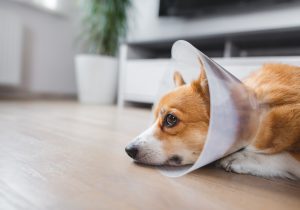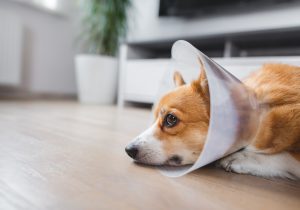
You’ve passed your beloved dog’s leash over to the capable hands of their vet, and it’s finally time for your pupper to be desexed. While the thought of your dog going through surgery might have your stomach in knots, you know after reading up on desexing that this is a low-risk, quick procedure that will be over in no time! All that’s left to do now is pick up your anesthetised pup and head home.
But, once you’ve got your doggo safely back in your care, you might find that the post-op healing process is trickier than you expected. What should you do if your dog refuses to wear their cone? How can you keep your energetic pup from running around the house? And when will they be ready to have their friendly Dog Walker take them out again?
In this article, we’re talking about everything you never expected after desexing your dog, and tips to deal with it. Read up while your doggo is still groggy from the pain meds, and you’ll be ready to be the perfect caretaker!
What to expect the first 24 to 48 hours
When you bring your sleepy furball home from the vet, you’ll want to make them as comfortable and relaxed as possible. Make sure that they have a quiet, warm place to recover with some familiar scents and their cozy dog bed. You might also want to dim the lights to encourage them to snooze through this early recovery phase.
As your pup starts to regain consciousness, you can expect the following:
-
- Little to no appetite. While it’s a good idea to offer your dog a light meal within a few hours of waking up from anesthesia, don’t be worried if Fido doesn’t seem interested. They should regain their normal appetite within a few days.
- Increased thirst. Some dogs experiencing anxiety will drink more water than usual, so don’t be surprised if your post-op pup seems thirsty. If your dog is puppy pad trained, consider placing their pad in the room to limit their movement.
- Diarrhoea. The medications used during surgery often cause loose stool in dogs. They should be back to normal after a few bowel movements.
- Difficulty sleeping and general restlessness. Unfortunately, your pup might be in for one or two uncomfortable nights before the disorientation and pain of their desexing wears off. During this time, your pup may appreciate some extra cuddles, while others will prefer to be left alone. Either way, whining, whimpering, and restlessness are normal.
How to deal with a doggo who hates their cone

The most important thing that you can do for your dog during this time is prevent them from licking their wound, which, of course, is where the cone comes in! But, what should you do if your dog refuses to wear it, or looks so heart-wrenchingly uncomfortable that you can’t bear to put it on them? Well, there are a few ways to approach this problem:
- If you have time before the surgery, desensitise your dog to the cone. For most dogs, desexing is a confusing and stressful experience. And the cone, which limits their ability to see and move freely, makes that even worse. If you have a few weeks before the surgery, consider desensitizing your dog to the cone. You can do this by putting it on them for short periods of time while offering plenty of positive praise, their favourite treats, or their meals.
- Opt for a more comfortable soft cone. Soft or inflatable recovery collars are typically more comfortable for dogs than hard plastic.
- Ditch the cone entirely. Some dogs prefer to wear a post-op body suit that prevents them from being able to access the wound. These stylish pajama-like suits allow them more freedom of movement, which can decrease stress.
Checking the wound for signs of healthy healing
Your vet will likely give you guidelines about how to check the wound and how often, but the general recommendation is that you take a peek twice per day. If the wound remains inflamed or red, or if you notice discharge or bleeding, you’ll want to contact your vet.
Over the next week or several days, you should notice the wound healing, but it will still be vulnerable to infection or damage until your dog has been cleared by the vet during their follow-up visit.
Ideas for keeping your pup inactive
Until your vet has given you the go-ahead, Fido will be on strict bedrest. Of course, this is easier said than done! Given that we often desex our dogs during the boisterous adolescent months, it can seem absolutely laughable to try to keep your puppy calm. That’s why you’ll want to have plenty of ways to keep your dog quietly occupied while they heal. Here are a few ideas:
- Invest in long-lasting chews and chew toys. Whether it’s a new kong, a treat-dispensing toy, pig trotters or a whole basket full of chew toys, you’ll want to have some new, interesting gifts for your dog. Instead of giving them all at once, keep them interested by offering one at a time.
- Set up scavenger hunts and snuffle mats. Scentwork is a brilliant way for your dog to burn off excess energy without strenuous movement. When you see them getting restless, have them lay down and wait for you to hide their favourite treats around the room or in a snuffle mat. The longer they have to sniff around for their snacks, the better!
- If your pupper is up for it, work on training new tricks that are easy on their body. To be sure, you don’t want to be training your dog for an obstacle course. But an easy trick training session can be a great way to exercise your dog’s mind. This might be the perfect time to teach them to shake, back up, touch objects with their nose or any other non-strenuous trick you can think of. Slow leash training is another fantastic training activity that you can do right at home. Simply take a few laps around the living room to reinforce the basics of leash training.
As you can see, it will take some creativity to limit your dog’s movements while their wounds heal. Keep an eye on them and be ready to step in to interrupt any zoomies that might overtake your doggo during this crucial healing phase. In the final stages of your dog’s healing process, you or their friendly Dog Walker can start taking them on short, relaxed walks to stretch their legs and provide some mental stimulation.
Be ready for some hormonal changes (sometimes for the worse!)
We often talk about the long-term effects of desexing on dog behaviour, including a reduced desire to roam or urine mark. But, you might be surprised to find out that your dog will undergo a short-term hormonal adjustment period in the weeks following the procedure, as well.
Over the course of several days, your dog’s nervous system will naturally respond to the absence of the sex organs by tapering off the release of certain hormones. In the meantime, you may notice some behavioural changes in your pup as the result of the hormonal imbalance. Every dog responds differently, but your dog may experience a spike in aggression, reactivity, or restlessness following the procedure. Stick with your normal training routine and have some patience! If behaviour issues persist after several weeks, consider seeking help from an animal behaviourist.
Before you know it, your desexed doggo will be back to normal!
Congratulations, you got your pup through their post-op healing phase. And as soon as their incision wound heals and they’ve adjusted to the hormonal change, your pupper will be ready to head back to the dog park and live life normally!